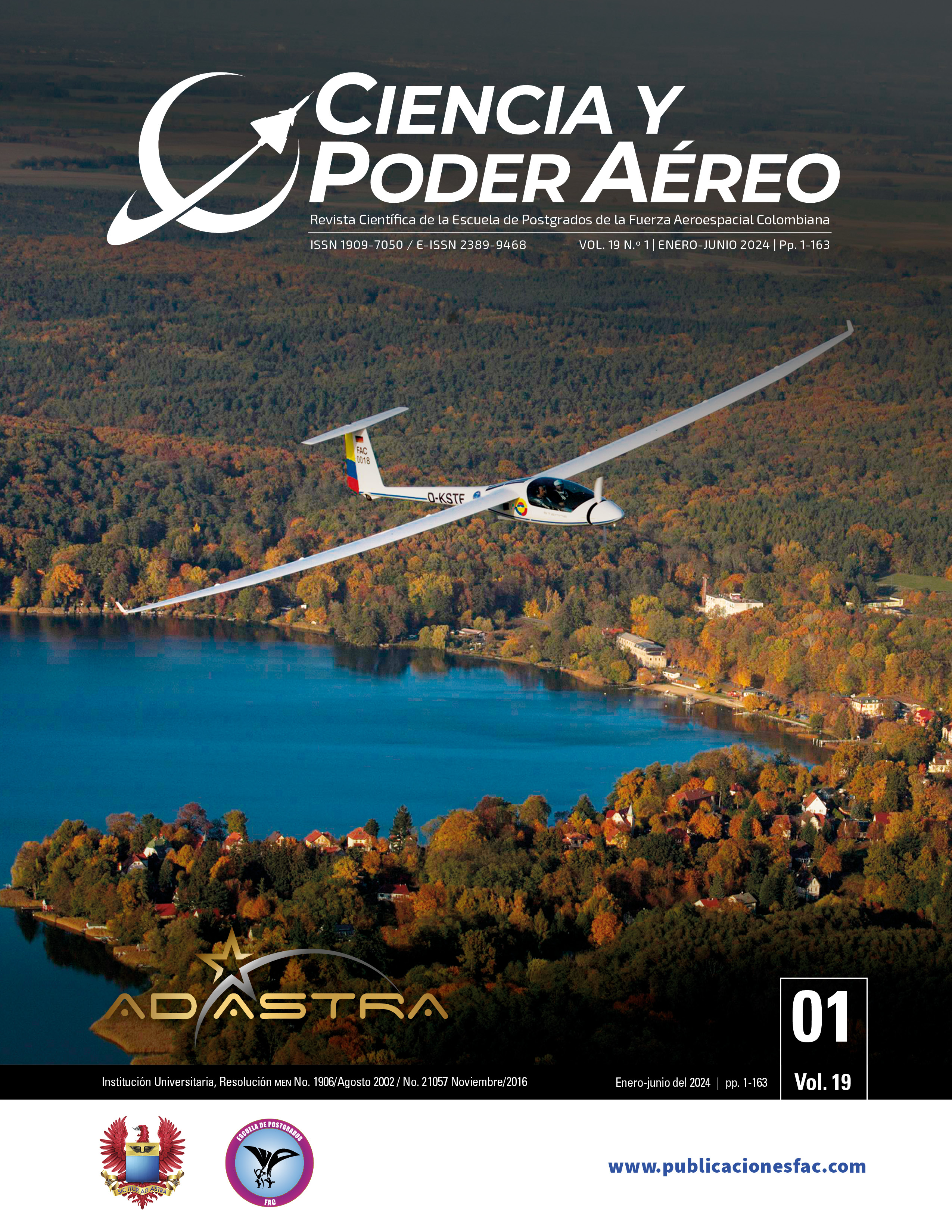Control of illicit flights, anoperational design approach
DOI:
https://doi.org/10.18667/cienciaypoderaereo.797Keywords:
Operational design, illegal flights, airspace controlAbstract
In 2015, the United Nations Organization (un) declared drug trafficking as a threat against the peace and comprehensive security of States, therefore, the United Nations Office on Drugs and Crime was created (unodc), whose purpose is to help acceding countries to combat indiscriminate drug trafficking and organized crime related to this activity. At the regional level, their fight has represented a real challenge, which demands the direct participation of the State, public institutions and the private sector, based on mutual cooperation programs, which allow the eradication of this scourge and its related crimes, among them, the trafficking of arms, ammunition and explosives, the illegal exploitation of natural resources, the use of organized criminal groups to carry out acts of hired assassins, extreme violence, intimidation, and others, which ultimately generate political, social and economic instability. For its part, Ecuador identifies current security as multidimensional, cooperative, democratic and humane, emphasizing the strengthening of bilateral relations with countries in the region, where “hard power” and deterrence alone do not have the desired effects, forcing its Armed Forces to redefine their strategies, to focus their ends, ways and means towards combating a threat that adapts and takes advantage of social, economic and political vulnerabilities. Currently, three aerial approaches to Ecuador have been determined, which highlights the importance of maintaining effective control of the airspace, considered as one of the road alternatives (2 % of all drugs) for the entry and exit of substances such as drugs in the country.
The article proposes an operational design for the control of illegal flights, which restricts the use of Ecuadorian airspace for drug trafficking activities, in order to achieve the neutralization of unidentified traffic and reduce the incidence of this illegal activity within the country, to which using a methodology from a descriptive approach, through documentary research in open sources from a holistic perspective, making a correlation of operational designs referring to the research topic and expert panel techniques, in the field of strategic planning, contributing experience of the authors on intelligence planning
Downloads
References
Bargent, J. (2019, 31 de octubre). Ecuador: autopista de la cocaina hacia Estados Unidos y Europa. In Sight Crime. https://es.insightcrime.org/noticias/analisis/ecuador-autopista-de-la-cocaina-hacia-estados-unidos-y-europa/
Bravo, G. y Rivera, R. (2020). Crimen organizado y cadenas de valor: el ascenso estratégico del Ecuador en la economía del narcotráfico. Revista Latinoamericana de Estudios de Seguridad, (28), 8-24. https://revistas.flacsoandes.edu.ec/urvio/article/view/4410
Centro de Inteligencia Estratégica (C.I.E.S.). (2023). Centro de Inteligencia Estratégica, Plan Específico de Inteligencia 2019-2030.
Cucalón, H. (2023, 18 de abril). Ecuador está “en guerra” por “terrorismo de crimen organizado”. Infobae Interviewer. https://www.infobae.com/america/agencias/2023/04/18/ecuador-esta-en-guerra-por-terrorismo-de-crimen-organizado-dice-ministro/
Fuerza Aérea Ecuatoriana. (2020). Manual de Instrucción de Planificación por Capacidades. https://www.fae.mil.ec/wp-content/uploads/2022/03/fuerza_aE%CC%81rea_ecuatoriana_2_rendiciO%CC%81n_de_cuentas.pdf
Guerrero, D. y Guillermo, B. (2023, 1 de abril). El Estado ecuatoriano y el crimen organizado. Revista de la Academia de Guerra Aérea del Ejército Ecuatoriano, 16(1), 12. https://journal.espe.edu.ec/ojs/index.php/Academia-de-guerra/article/view/2987
Jácome Rosenfeld, A. I. (2013). Drogas en el Ecuador: ¿política prohibita o democracia deliberativa? Revista Latinoamericana de Seguridad Ciudadana, (13). http://hdl.handle.net/10469/5469
Ministerio de Defensa Nacional. (2018). Políticas de la Defensa Nacional "Libro Blanco". https://www.elcomercio.com/actualidad/aeronave-detectada-isla-puna-guayas.html
ONU. (2021). World Drug Report 2021. https://www.unodc.org/unodc/en/data-and-analysis/wdr2021.html
Solis, L. G. y Rojas, F. (2008). Crimen organizado en América Latina y el Caribe. Flacso Andes. https://biblio.flacsoandes.edu.ec/libros/digital/42589.pdf
UNODC. (2023). Oficina de las Naciones Unidas Contra la Droga y el Delito. https://www.unov.org/unov/es/unodc.html#:~:text=el%20Delito%20(UNODC)-,La%20Oficina%20de%20las%20Naciones%20Unidas%20contra%20la%20Droga%20y,Naciones%20Unidas%20contra%20el%20terrorismo
Downloads
Published
Issue
Section
License
Copyright (c) 2023 Escuela de Postgrados de la Fuerza Aérea Colombiana

This work is licensed under a Creative Commons Attribution 4.0 International License.
Assignment of Copyrights
Authors assign Ciencia y Poder Aéreo journal the exclusive rights (reproduction, distribution, public communication, and transformation) to exploit and commercialize their work, in whole or in part, in all the formats and modalities of present or future exploitation, in all languages, throughout the life of the work and throughout the world.
All contents published in Ciencia y Poder Aéreo journal are licensed under a Creative Commons Attribution 4.0 International License, whose complete information is available at http://creativecommons.org/licenses/by/4.0/
Under the terms of this license, users are free to download, print, extract, archive, distribute and publicly communicate the content of articles, provided that proper credit is granted to authors and Ciencia y Poder Aéreo, scientific journal of the Graduate School of the Colombian Air Force. Except when otherwise indicated, this site and its contents are licensed under a Creative Commons Attribution 4.0 International License.
For other uses not considered under this license it is required to contact the Director or the Editor of the journal at the e-mail address cienciaypoderaereo1@gmail.com.
The Graduate School of the Colombian Air Force and this publication are not responsible for the concepts expressed in the articles, including the metadata or the affiliation stated by authors. This is the full responsibility of the authors.






















